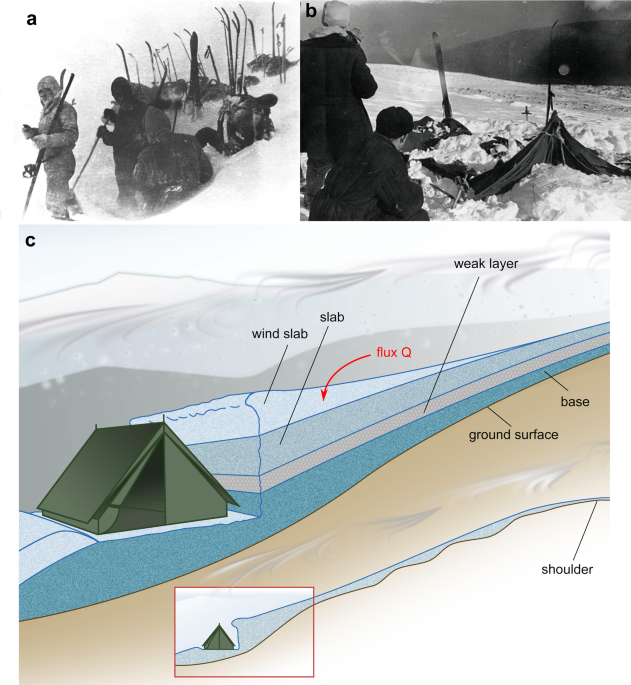"Buried" being the operative word here. Basically, the only way for the problem to go away is for the snow/layer to melt.
Not true. Snowpack metamorphizes happen. Bridging is a real thing. Avalanches flush layers.
"Buried" being the operative word here. Basically, the only way for the problem to go away is for the snow/layer to melt.
This is really important. It’s obviously true that slopes of 30° or less aren’t as prone to sliding as steeper ones but it’s absolutely no guarantee. Much depends on the crack-face friction characteristics of the snow in the area in question. Slopes as shallow as 20° can slide! You can bet that this would be a year when that might happen.But all that said, this is clearly an area with significant terrain over the "rule of thumb" 30 degrees, which is just a rule of thumb anyway as has been discussed above regarding the Mill Creek slide
Slopes as shallow as 20° can slide! You can bet that this would be a year when that might happen.

Interesting. What a bizarre event. Still doesn’t explain a bunch of the injuries and other weird things, but the avalanche theory itself seems plausible.
Mechanisms of slab avalanche release and impact in the Dyatlov Pass incident in 1959
An unsolved fatal accident of 9 Russian mountaineers in the northern Urals in 1959 can be explained by a slab avalanche released due to a slope cut to install the tent and wind-blown snow accumulation affected by an irregular topography, according to analytical and numerical models.
www.nature.com
To quote:
“While a 28° slope may still be perceived as being too mild to cause an avalanche—based on the often-quoted and implicit rule of thumb that a minimum of 30° is required10—in reality, the critical slope angle can be as low11 as 20° (Fig. 2b), provided the dynamic friction angle (sometimes called crack-face friction11) of the snow is sufficiently low. In fact, field measurements have shown that the dynamic friction angle of snow can be as low as 15°, especially for very low temperatures12.”
The references in the Nature article speak to your question. Certainly mid-winter slides happen at slope angles well below 30° although I’d think 20° must be exceptional.
I think that's the right area... FATMAP does have slightly different shading. It's probably right around 35 degrees and/or may depend on what topo maps and data underlie the shading. Caltopo shows something similar, with pockets above and below 35 degrees.
FATMAP view:
View attachment 124721
But all that said, this is clearly an area with significant terrain over the "rule of thumb" 30 degrees, which is just a rule of thumb anyway as has been discussed above regarding the Mill Creek slide.
The only point in talking about 35 degrees, was that a lot of the area is below that, so it may not be viewed as "extreme" terrain, or what folks in resorts would think is beyond any normal steepness. I was responding to a comment that it looks "relatively tame and not very steep at all". But certainly still clear avy terrain.

Mechanisms of slab avalanche release and impact in the Dyatlov Pass incident in 1959
An unsolved fatal accident of 9 Russian mountaineers in the northern Urals in 1959 can be explained by a slab avalanche released due to a slope cut to install the tent and wind-blown snow accumulation affected by an irregular topography, according to analytical and numerical models.
www.nature.com
To quote:
“While a 28° slope may still be perceived as being too mild to cause an avalanche—based on the often-quoted and implicit rule of thumb that a minimum of 30° is required10—in reality, the critical slope angle can be as low11 as 20° (Fig. 2b), provided the dynamic friction angle (sometimes called crack-face friction11) of the snow is sufficiently low. In fact, field measurements have shown that the dynamic friction angle of snow can be as low as 15°, especially for very low temperatures12.”
The references in the Nature article speak to your question. Certainly mid-winter slides happen at slope angles well below 30° although I’d think 20° must be exceptional.
There used to be a gate up high skier's left of rock chutes. I think they keep moving it higher and I'm not sure if its there anymore. It was more used for golden bear and hanger/citadel laps I thought.^^^ There's a trailhead at the Loveland Pass exit plus a gate near the bottom of 8. I've only hiked from the I-70 trailhead in the summer. Not sure which access most skiers use.
I put a red circle at the approximate location of the backcountry gate. I don't think there's another gate up higher, but someone please correct me if I'm wrong.
View attachment 124616

FATMAP: 3D Map & Guides for Skiing, Hiking and Biking
Plan your next route like a pro and find 1000s of routes from our community of guides, athletes and locals. With a free online route planner and GPX export.fatmap.com
There used to be a gate up high skier's left of rock chutes. I think they keep moving it higher and I'm not sure if its there anymore. It was more used for golden bear and hanger/citadel laps I thought.
Based on my experience, many AIARE instructors use float packs. My feeling is that education, and not leaving your airbag pack at home, is the solution. AIARE Level 1 courses emphasize using the avy forecast to choice safe terrain options. The L1 class much more focused learning on safe travel through avalanche terrain, group dynamics, team communication and reinforces decision-making by consensus. There is not a lot of emphasis on snow science.I finally had a chance to listen to this whole thing. Really interesting conversation, with a lot of good information. I few points that stood out to me in the discussion:
- Discussion on float packs and if they give you a false sense of security, or are they actually safer. I feel like both of these things are true. My instructor for an AIARE course discussed the impacts float packs had on his decision making. For a period of time he always wore one, and slowly realized he made less conservative decisions when he had it. Now he leaves it home more and that takes the decision away from him when he's in those questionable areas.
- Discussion on the emphasis on snow pits in AIARE courses, and how there should be more emphasis on terrain management and "feeling" the snow, rather than full blown snow science. Not saying they should take pits out of the equation, just that they may not be the most important thing for people to learn that are starting off in the backcountry. They did discuss the importance of feeling the snow, testing with your poles, and hasty pits.
Based on my experience, many AIARE instructors use float packs. My feeling is that education, and not leaving your airbag pack at home, is the solution.
AIARE Level 1 courses emphasize using the avy forecast to choice safe terrain options. The L1 class much more focused learning on safe travel through avalanche terrain, group dynamics, team communication and reinforces decision-making by consensus. There is not a lot of emphasis on snow science.
Whoops, I mis-read your post. In the IFMGA guiding and avy education community, many professionals use airbags, and I always discuss the proper use of float bags while teaching L1 classes. There have been a few studies regarding airbags and increased risk acceptance and a link to Pascal’s recent study -https://www.sciencedirect.com/science/article/pii/S2213078019300817I think there's a time and a place for airbags. But if you're making a decision to stay out of avalanche terrain based on the current conditions, I think it's fine to leave that pack at home. When you make that decision, you're committing to staying off of that terrain regardless of your feeling when you get to the trailhead...it's essentially putting all avalanche terrain (and below it) into your "red zone" for the day.
This was also my experience when taking an L1 class as well. Maybe this is the norm? I made the point based on what was discussed in the interview.
This argument of higher risk acceptance for airbags was also applied to helmets when they first became popular. But once helmets became ubiquitous and just normal safety gear, imo they no longer elicited above normal risky behaviour. I suggest that wider acceptance and use of airbags could also result in no increase in risk acceptance going forward.there have been a few studies regarding airbags and increased risk acceptance
I don't know that that's actually true.But once helmets became ubiquitous and just normal safety gear, imo they no longer elicited above normal risky behaviour.
This argument of higher risk acceptance for airbags was also applied to helmets when they first became popular. But once helmets became ubiquitous and just normal safety gear, imo they no longer elicited above normal risky behaviour. I suggest that wider acceptance and use of airbags could also result in no increase in risk acceptance going forward.
I'm way more likely to quickly pull the bar down without asking anyone when everyone on the chair is wearing a helmet.Do you think what is considered "normal risky behavior" has changed due to the use of helmets?

Yeah, that is why I wrote "imo" because there is no real way of knowing for sure, but it is interesting to consider the impact of safety devices on risk behaviour.I don't know that that's actually true.